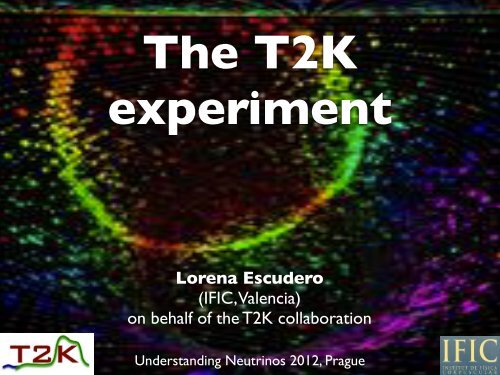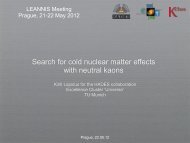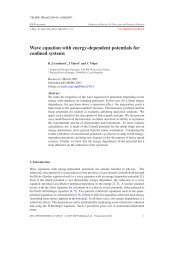Lorena Escudero (IFIC, Valencia) on behalf of the T2K collaboration
Lorena Escudero (IFIC, Valencia) on behalf of the T2K collaboration
Lorena Escudero (IFIC, Valencia) on behalf of the T2K collaboration
You also want an ePaper? Increase the reach of your titles
YUMPU automatically turns print PDFs into web optimized ePapers that Google loves.
Understanding Neutrinos 20124<str<strong>on</strong>g>Lorena</str<strong>on</strong>g> <str<strong>on</strong>g>Escudero</str<strong>on</strong>g>The Far Detector: SKMu<strong>on</strong> neutrino event(νμ μ clear single ring)Electr<strong>on</strong> neutrino event(νe e EM shower, fuzzy ring)22.5kt<strong>on</strong> water Cherenkovdetector.Cherenkov phot<strong>on</strong>s reach PMTsand produce ring-shaped hit patternMC eventMC event
Understanding Neutrinos 20125<str<strong>on</strong>g>Lorena</str<strong>on</strong>g> <str<strong>on</strong>g>Escudero</str<strong>on</strong>g>The Near Detectors I:INGRID(ON Axis)INGRID (Interactive Neutrino GRID) m<strong>on</strong>itors directly <strong>the</strong>neutrino beam directi<strong>on</strong> and intensity by means <strong>of</strong> neutrinointeracti<strong>on</strong>s in ir<strong>on</strong>.Each INGRID module is composed <strong>of</strong> ir<strong>on</strong> plates +scintillator layers in a sandwich.
The Near Detectors II:ND280(OFF Axis)ND280 goal is to measure <strong>the</strong> flux, energyspectrum and νe c<strong>on</strong>taminati<strong>on</strong>.Cross secti<strong>on</strong> studies are also performed.ECALElectromagnetic calorimeters (plasticscintillator).Understanding Neutrinos 20126<str<strong>on</strong>g>Lorena</str<strong>on</strong>g> <str<strong>on</strong>g>Escudero</str<strong>on</strong>g>
The Near Detectors II:ND280(OFF Axis)ND280 goal is to measure <strong>the</strong> flux, energyspectrum and νe c<strong>on</strong>taminati<strong>on</strong>.Cross secti<strong>on</strong> studies are also performed.ECALElectromagnetic calorimeters (plasticscintillator).ND280 Magnet & SMRDOld CERN UA1/NOMAD magnet (0.2T)MUON detector (SMRD): scintillatorinserted in magnet air gapsUnderstanding Neutrinos 20126<str<strong>on</strong>g>Lorena</str<strong>on</strong>g> <str<strong>on</strong>g>Escudero</str<strong>on</strong>g>
The Near Detectors II:ND280(OFF Axis)ND280 goal is to measure <strong>the</strong> flux, energyspectrum and νe c<strong>on</strong>taminati<strong>on</strong>.Cross secti<strong>on</strong> studies are also performed.ECALElectromagnetic calorimeters (plasticscintillator).ND280 Magnet & SMRDOld CERN UA1/NOMAD magnet (0.2T)MUON detector (SMRD): scintillatorinserted in magnet air gapsPi 0 detector (P∅D)Scintillator + water detector.Optimized for γ detecti<strong>on</strong> and π0rec<strong>on</strong>structi<strong>on</strong> (neutrino NC process).Understanding Neutrinos 20126<str<strong>on</strong>g>Lorena</str<strong>on</strong>g> <str<strong>on</strong>g>Escudero</str<strong>on</strong>g>
The Near Detectors II:ND280(OFF Axis)ND280 goal is to measure <strong>the</strong> flux, energyspectrum and νe c<strong>on</strong>taminati<strong>on</strong>.Cross secti<strong>on</strong> studies are also performed.ECALElectromagnetic calorimeters (plasticscintillator).TRACKER3 Time Projecti<strong>on</strong> Chambers (TPCs)- They rec<strong>on</strong>struct momentum and charge<strong>of</strong> particles.2 Fine Grained Detectors (FGDs)- Active target for neutrino interacti<strong>on</strong>s:carb<strong>on</strong> + water.ND280 Magnet & SMRDOld CERN UA1/NOMAD magnet (0.2T)MUON detector (SMRD): scintillatorinserted in magnet air gapsPi 0 detector (P∅D)Scintillator + water detector.Optimized for γ detecti<strong>on</strong> and π0rec<strong>on</strong>structi<strong>on</strong> (neutrino NC process).Understanding Neutrinos 20126<str<strong>on</strong>g>Lorena</str<strong>on</strong>g> <str<strong>on</strong>g>Escudero</str<strong>on</strong>g>
The Near Detectors II:ND280(OFF Axis)ND280 goal is to measure <strong>the</strong> flux, energyspectrum and νe c<strong>on</strong>taminati<strong>on</strong>.Cross secti<strong>on</strong> studies are also performed.ECALElectromagnetic calorimeters (plasticscintillator).TRACKER3 Time Projecti<strong>on</strong> Chambers (TPCs)- They rec<strong>on</strong>struct momentum and charge<strong>of</strong> particles.2 Fine Grained Detectors (FGDs)- Active target for neutrino interacti<strong>on</strong>s:carb<strong>on</strong> + water.ND280 Magnet & SMRDOld CERN UA1/NOMAD magnet (0.2T)MUON detector (SMRD): scintillatorinserted in magnet air gapsPi 0 detector (P∅D)Scintillator + water detector.Optimized for γ detecti<strong>on</strong> and π0rec<strong>on</strong>structi<strong>on</strong> (neutrino NC process).Understanding Neutrinos 20126<str<strong>on</strong>g>Lorena</str<strong>on</strong>g> <str<strong>on</strong>g>Escudero</str<strong>on</strong>g>
The Near Detectors II:ND280(OFF Axis)ND280 goal is to measure <strong>the</strong> flux, energyspectrum and νe c<strong>on</strong>taminati<strong>on</strong>.Cross secti<strong>on</strong> studies are also performed.ECALElectromagnetic calorimeters (plasticscintillator).TRACKER3 Time Projecti<strong>on</strong> Chambers (TPCs)- They rec<strong>on</strong>struct momentum and charge<strong>of</strong> particles.2 Fine Grained Detectors (FGDs)- Active target for neutrino interacti<strong>on</strong>s:carb<strong>on</strong> + water.ND280 Magnet & SMRDOld CERN UA1/NOMAD magnet (0.2T)MUON detector (SMRD): scintillatorinserted in magnet air gapsPi 0 detector (P∅D)Scintillator + water detector.Optimized for γ detecti<strong>on</strong> and π0rec<strong>on</strong>structi<strong>on</strong> (neutrino NC process).Understanding Neutrinos 20126<str<strong>on</strong>g>Lorena</str<strong>on</strong>g> <str<strong>on</strong>g>Escudero</str<strong>on</strong>g>
Understanding Neutrinos 20127<str<strong>on</strong>g>Lorena</str<strong>on</strong>g> <str<strong>on</strong>g>Escudero</str<strong>on</strong>g>Oscillati<strong>on</strong> Analysis Method
Understanding Neutrinos 20127<str<strong>on</strong>g>Lorena</str<strong>on</strong>g> <str<strong>on</strong>g>Escudero</str<strong>on</strong>g>Oscillati<strong>on</strong> Analysis MethodFlux predicti<strong>on</strong>• Beam MC• Hadr<strong>on</strong> producti<strong>on</strong> (NA61)ND280 analysis• Detector MC• νμ measurements in CC QEand n<strong>on</strong>QE samplesν cross secti<strong>on</strong>s• NEUT MC model• Uncertainties set fromexternal data
Understanding Neutrinos 20127<str<strong>on</strong>g>Lorena</str<strong>on</strong>g> <str<strong>on</strong>g>Escudero</str<strong>on</strong>g>Oscillati<strong>on</strong> Analysis MethodFlux predicti<strong>on</strong>• Beam MC• Hadr<strong>on</strong> producti<strong>on</strong> (NA61)ND280 analysis• Detector MC• νμ measurements in CC QEand n<strong>on</strong>QE samplesν cross secti<strong>on</strong>s• NEUT MC model• Uncertainties set fromexternal dataFlux+cross secti<strong>on</strong> FITTo c<strong>on</strong>strain flux and ν interacti<strong>on</strong>cross secti<strong>on</strong> uncertaintiesnear detectoruncertainties
Understanding Neutrinos 20127<str<strong>on</strong>g>Lorena</str<strong>on</strong>g> <str<strong>on</strong>g>Escudero</str<strong>on</strong>g>Oscillati<strong>on</strong> Analysis MethodFlux predicti<strong>on</strong>• Beam MC• Hadr<strong>on</strong> producti<strong>on</strong> (NA61)ND280 analysis• Detector MC• νμ measurements in CC QEand n<strong>on</strong>QE samplesν cross secti<strong>on</strong>s• NEUT MC model• Uncertainties set fromexternal dataFlux+cross secti<strong>on</strong> FITTo c<strong>on</strong>strain flux and ν interacti<strong>on</strong>cross secti<strong>on</strong> uncertaintiesnear detectoruncertaintiesFar detector analysis
Understanding Neutrinos 20127<str<strong>on</strong>g>Lorena</str<strong>on</strong>g> <str<strong>on</strong>g>Escudero</str<strong>on</strong>g>Oscillati<strong>on</strong> Analysis MethodFlux predicti<strong>on</strong>• Beam MC• Hadr<strong>on</strong> producti<strong>on</strong> (NA61)ND280 analysis• Detector MC• νμ measurements in CC QEand n<strong>on</strong>QE samplesν cross secti<strong>on</strong>s• NEUT MC model• Uncertainties set fromexternal dataFlux+cross secti<strong>on</strong> FITTo c<strong>on</strong>strain flux and ν interacti<strong>on</strong>cross secti<strong>on</strong> uncertaintiesnear detectoruncertaintiesFar detector analysisMC Predicti<strong>on</strong>• SK detector MC• Calculate predicti<strong>on</strong> (eventrates, spectra) at different osc.hypo<strong>the</strong>sesExtrapolati<strong>on</strong>Propagate using data/MC ratioand near/far flux transfer matrix
Understanding Neutrinos 20127<str<strong>on</strong>g>Lorena</str<strong>on</strong>g> <str<strong>on</strong>g>Escudero</str<strong>on</strong>g>Oscillati<strong>on</strong> Analysis MethodFlux predicti<strong>on</strong>• Beam MC• Hadr<strong>on</strong> producti<strong>on</strong> (NA61)ND280 analysis• Detector MC• νμ measurements in CC QEand n<strong>on</strong>QE samplesν cross secti<strong>on</strong>s• NEUT MC model• Uncertainties set fromexternal dataFlux+cross secti<strong>on</strong> FITTo c<strong>on</strong>strain flux and ν interacti<strong>on</strong>cross secti<strong>on</strong> uncertaintiesnear detectoruncertaintiesFar detector analysisMC Predicti<strong>on</strong>• SK detector MC• Calculate predicti<strong>on</strong> (eventrates, spectra) at different osc.hypo<strong>the</strong>sesData•<strong>T2K</strong> event candidatesExtrapolati<strong>on</strong>Propagate using data/MC ratioand near/far flux transfer matrix
Understanding Neutrinos 20127<str<strong>on</strong>g>Lorena</str<strong>on</strong>g> <str<strong>on</strong>g>Escudero</str<strong>on</strong>g>Oscillati<strong>on</strong> Analysis MethodFlux predicti<strong>on</strong>• Beam MC• Hadr<strong>on</strong> producti<strong>on</strong> (NA61)ND280 analysis• Detector MC• νμ measurements in CC QEand n<strong>on</strong>QE samplesν cross secti<strong>on</strong>s• NEUT MC model• Uncertainties set fromexternal dataFlux+cross secti<strong>on</strong> FITTo c<strong>on</strong>strain flux and ν interacti<strong>on</strong>cross secti<strong>on</strong> uncertaintiesnear detectoruncertaintiesFar detector analysisMC Predicti<strong>on</strong>• SK detector MC• Calculate predicti<strong>on</strong> (eventrates, spectra) at different osc.hypo<strong>the</strong>sesData•<strong>T2K</strong> event candidatesExtrapolati<strong>on</strong>Propagate using data/MC ratioand near/far flux transfer matrixOscillati<strong>on</strong> FITCompare data andexpectati<strong>on</strong>s to extract<strong>the</strong> values <strong>of</strong> <strong>the</strong>oscillati<strong>on</strong> parameterso<strong>the</strong>runcertainties
2010 νμ Disappearance Analysis: SELECTIONRUN1+2 = 1.43 E20 POTAt <strong>the</strong> far detector a νμ CCQEenriched sample is selected.CUTEVENTS (DATA)FCFV (+beam timing) 88Single Ring 41PID (μ-like) 33pμ > 200MeV 33< 2 decay e - 31Understanding Neutrinos 20128<str<strong>on</strong>g>Lorena</str<strong>on</strong>g> <str<strong>on</strong>g>Escudero</str<strong>on</strong>g>
2010 νμ Disappearance Analysis: SELECTIONRUN1+2 = 1.43 E20 POTAt <strong>the</strong> far detector a νμ CCQEenriched sample is selected.CUTEVENTS (DATA)FCFV (+beam timing) 88Single Ring 41PID (μ-like) 33pμ > 200MeV 33< 2 decay e - 31Understanding Neutrinos 20128<str<strong>on</strong>g>Lorena</str<strong>on</strong>g> <str<strong>on</strong>g>Escudero</str<strong>on</strong>g>
2010 νμ Disappearance Analysis: SELECTIONRUN1+2 = 1.43 E20 POTAt <strong>the</strong> far detector a νμ CCQEenriched sample is selected.CUTEVENTS (DATA)FCFV (+beam timing) 88Single Ring 41PID (μ-like) 33pμ > 200MeV 33< 2 decay e - 31Understanding Neutrinos 20128<str<strong>on</strong>g>Lorena</str<strong>on</strong>g> <str<strong>on</strong>g>Escudero</str<strong>on</strong>g>
2010 νμ Disappearance Analysis: SELECTIONRUN1+2 = 1.43 E20 POTAt <strong>the</strong> far detector a νμ CCQEenriched sample is selected.CUTEVENTS (DATA)FCFV (+beam timing) 88Single Ring 41PID (μ-like) 33pμ > 200MeV 33< 2 decay e - 31Understanding Neutrinos 20128Based <strong>on</strong> shape <strong>of</strong> ring<str<strong>on</strong>g>Lorena</str<strong>on</strong>g> <str<strong>on</strong>g>Escudero</str<strong>on</strong>g>
2010 νμ Disappearance Analysis: SELECTIONRUN1+2 = 1.43 E20 POTAt <strong>the</strong> far detector a νμ CCQEenriched sample is selected.CUTEVENTS (DATA)FCFV (+beam timing) 88Single Ring 41PID (μ-like) 33pμ > 200MeV 33< 2 decay e - 31Understanding Neutrinos 20128Based <strong>on</strong> shape <strong>of</strong> ring<str<strong>on</strong>g>Lorena</str<strong>on</strong>g> <str<strong>on</strong>g>Escudero</str<strong>on</strong>g>
2010 νμ Disappearance Analysis: SELECTIONRUN1+2 = 1.43 E20 POTAt <strong>the</strong> far detector a νμ CCQEenriched sample is selected.CUTEVENTS (DATA)FCFV (+beam timing) 88Single Ring 41PID (μ-like) 33pμ > 200MeV 33< 2 decay e - 31Understanding Neutrinos 20128Based <strong>on</strong> shape <strong>of</strong> ring<str<strong>on</strong>g>Lorena</str<strong>on</strong>g> <str<strong>on</strong>g>Escudero</str<strong>on</strong>g>
2010 νμ Disappearance Analysis: SELECTIONRUN1+2 = 1.43 E20 POTAt <strong>the</strong> far detector a νμ CCQEenriched sample is selected.CUTEVENTS (DATA)FCFV (+beam timing) 88Single Ring 41PID (μ-like) 33pμ > 200MeV 33< 2 decay e - 31Last two vetoes rejectevents with unseenmu<strong>on</strong>s and pi<strong>on</strong>sUnderstanding Neutrinos 20128Based <strong>on</strong> shape <strong>of</strong> ring<str<strong>on</strong>g>Lorena</str<strong>on</strong>g> <str<strong>on</strong>g>Escudero</str<strong>on</strong>g>
Understanding Neutrinos 20129<str<strong>on</strong>g>Lorena</str<strong>on</strong>g> <str<strong>on</strong>g>Escudero</str<strong>on</strong>g>2010 νμ Disappearance Analysis: RESULTS90% CLEVENTS EXPECTED• No oscillati<strong>on</strong>: 106(No oscillati<strong>on</strong> excluded at 4.5σ)• Maximal oscillati<strong>on</strong> (sin 2 (2θ23)=1,Δm 2 23 = 2.4E-3eV 2 ): 28.3EVENTS OBSERVED: 31• Two independent analyses d<strong>on</strong>e, withc<strong>on</strong>sistent results• Results in full agreement withMINOS, SK
Understanding Neutrinos 201210<str<strong>on</strong>g>Lorena</str<strong>on</strong>g> <str<strong>on</strong>g>Escudero</str<strong>on</strong>g>2012 νe Appearance Analysis: SELECTIONRUN1+2+3 = 3E20 POTCUTEVENTS (DATA)FCFV (+beam timing) 174Single Ring 88PID (e-like) 22Evis > 100MeV 21No decay e - 16Inv. mass cut 11Eν rec
Understanding Neutrinos 201210<str<strong>on</strong>g>Lorena</str<strong>on</strong>g> <str<strong>on</strong>g>Escudero</str<strong>on</strong>g>2012 νe Appearance Analysis: SELECTIONRUN1+2+3 = 3E20 POTCUTEVENTS (DATA)FCFV (+beam timing) 174Single Ring 88PID (e-like) 22Evis > 100MeV 21No decay e - 16Inv. mass cut 11Eν rec
Understanding Neutrinos 201210<str<strong>on</strong>g>Lorena</str<strong>on</strong>g> <str<strong>on</strong>g>Escudero</str<strong>on</strong>g>2012 νe Appearance Analysis: SELECTIONRUN1+2+3 = 3E20 POTCUTEVENTS (DATA)FCFV (+beam timing) 174Single Ring 88PID (e-like) 22Evis > 100MeV 21No decay e - 16Inv. mass cut 11Eν rec
Understanding Neutrinos 201210<str<strong>on</strong>g>Lorena</str<strong>on</strong>g> <str<strong>on</strong>g>Escudero</str<strong>on</strong>g>2012 νe Appearance Analysis: SELECTIONRUN1+2+3 = 3E20 POTCUTEVENTS (DATA)FCFV (+beam timing) 174Single Ring 88PID (e-like) 22Evis > 100MeV 21No decay e - 16Inv. mass cut 11Eν rec
Understanding Neutrinos 201210<str<strong>on</strong>g>Lorena</str<strong>on</strong>g> <str<strong>on</strong>g>Escudero</str<strong>on</strong>g>2012 νe Appearance Analysis: SELECTIONRUN1+2+3 = 3E20 POTCUTEVENTS (DATA)FCFV (+beam timing) 174Single Ring 88PID (e-like) 22Evis > 100MeV 21No decay e - 16Inv. mass cut 11Eν rec
2012 νe Appearance Analysis: SELECTIONRUN1+2+3 = 3E20 POTCUTEVENTS (DATA)FCFV (+beam timing) 174Single Ring 88PID (e-like) 22Evis > 100MeV 21No decay e - 16Inv. mass cut 11Eν rec
2012 νe Appearance Analysis: SELECTIONRUN1+2+3 = 3E20 POTCUTEVENTS (DATA)FCFV (+beam timing) 174Single Ring 88PID (e-like) 22Evis > 100MeV 21No decay e - 16Inv. mass cut 11Eν rec
2012 νe Appearance Analysis: SELECTIONRUN1+2+3 = 3E20 POTCUTEVENTS (DATA)FCFV (+beam timing) 174Single Ring 88PID (e-like) 22Evis > 100MeV 21No decay e - 16Inv. mass cut 11Eν rec
2012 νe Appearance Analysis: SELECTIONRUN1+2+3 = 3E20 POTCUTEVENTS (DATA)FCFV (+beam timing) 174Single Ring 88PID (e-like) 22Evis > 100MeV 21No decay e - 16Inv. mass cut 11Eν rec
Understanding Neutrinos 201211<str<strong>on</strong>g>Lorena</str<strong>on</strong>g> <str<strong>on</strong>g>Escudero</str<strong>on</strong>g>2012 νe Appearance Analysis: RESULTSBEST FIT(with 68% CL error, @δCP=0)• Normal hierarchy• Inverted hierarchy
C<strong>on</strong>clusi<strong>on</strong>s / Future Plans<strong>T2K</strong> has been taking data since 2010.We are reporting evidence <strong>of</strong> νe appearance. Latestresult, based <strong>on</strong> 3E20 POT, recently reported (ICHEP 2012).θ13 values compatible with reactor experiments.Updated results <strong>on</strong> νμ disappearance coming so<strong>on</strong>.Current θ23, Δm 2 23 values compatible with MINOS, SKSummer 2012 shutdown underway.Data taking will be restarted in October 2012Planned to take more data at higher beam powerUnderstanding Neutrinos 201212<str<strong>on</strong>g>Lorena</str<strong>on</strong>g> <str<strong>on</strong>g>Escudero</str<strong>on</strong>g>
Thanks for your attenti<strong>on</strong>!REFERENCES[1] The <strong>T2K</strong> ExperimentNIMA, DOI number: 10.1016/j.nima.2011.06.067 (2011) arXiv:1106.1238[2] Indicati<strong>on</strong> <strong>of</strong> Electr<strong>on</strong> Neutrino Appearance from anAccelerator-Produced Off-axis Mu<strong>on</strong> Neutrino Beam:Phys. Rev. Lett. 107, 041801 (2011)[3] First mu<strong>on</strong>-neutrino disappearance study with an <strong>of</strong>f-axisbeamPhys. Rev. D 85, 031103(R) (2012) arXiv:1201.1386
BACKUP
Some Neutrino PhysicsNEUTRINO MIXINGMatrix c<strong>on</strong>necting mass and flavor eigenstates (PMNS)6 independent parameters describing oscillati<strong>on</strong>s: 3 angles, 2 masssplitting parameters and <strong>on</strong>e phase:Solar parameters(very well known)θ12, Δm 2 12Atmospheric parameters(well known)θ23, Δm 2 2315Interferenceparameters (unknown)θ13, δCP
The <strong>T2K</strong> Collaborati<strong>on</strong>12 countries61 instituti<strong>on</strong>s~500 authorsPublic website:http://t2kexperiment.org/16
The Beam18
19The Off Axis Methodsec<strong>on</strong>darybeamline<strong>T2K</strong> is <strong>the</strong> first l<strong>on</strong>g baseline experiment using <strong>the</strong> <strong>of</strong>f-axistechnique. The current <strong>of</strong>f-axis angle is 2.5º(2º-2.5º range allowedby <strong>the</strong> facility design).Characteristics/advantages <strong>of</strong> <strong>the</strong> <strong>of</strong>f-axis method:Narrow beam with peak energy at maximum <strong>of</strong> νμ νeoscillati<strong>on</strong> (∼600MeV).CCQE sample enhanced: high energy tails <strong>of</strong> <strong>the</strong> beam reduced(background from n<strong>on</strong>-QE and NC to oscillati<strong>on</strong> signalreduced).Dependence <strong>of</strong> Eν from Eπ reduced.
The Far Detector: SKMu<strong>on</strong> neutrino event(νμ μ clear single ring)Electr<strong>on</strong> neutrino event(νe e EM shower, fuzzy ring)20Water Cherenkov detector.1 km deep underground.Cylindrical shape with 39 m ∅and 42 m height.Filled with 50 kt<strong>on</strong> <strong>of</strong> pure water(fiducial volume 22.5 kt<strong>on</strong>).PMTs: 11.146 in <strong>the</strong> inner regi<strong>on</strong>.Cherenkov phot<strong>on</strong>s reach PMTsand produce ring-shaped hit patternUsing <strong>the</strong> timing and chargeinformati<strong>on</strong>, <strong>the</strong> interacti<strong>on</strong> vertex,ring directi<strong>on</strong> and flavor <strong>of</strong> incomingparticle (from <strong>the</strong> sharpness <strong>of</strong> edge<strong>of</strong> ring) are determined.
21The Near Detectors I:INGRID(ON Axis)Prot<strong>on</strong>moduleINGRID (Interactive Neutrino GRID) m<strong>on</strong>itors directly <strong>the</strong>neutrino beam directi<strong>on</strong> and intensity by means <strong>of</strong> neutrinointeracti<strong>on</strong>s in ir<strong>on</strong>. The beam stability <strong>on</strong> a day-by-day basis isstudied in this way.INGRID c<strong>on</strong>sists <strong>of</strong>14 <strong>on</strong>-axis modules (horiz<strong>on</strong>tal+vertical) forming a cross.2 extra <strong>of</strong>f-axis modules used to study <strong>the</strong> axial symmetry<strong>of</strong> <strong>the</strong> beam.Each module (7 t<strong>on</strong>) is composed <strong>of</strong> 9 ir<strong>on</strong> plates + 11scintillator layers in a sandwich (10mx10m).An extra module, Prot<strong>on</strong> Module, without ir<strong>on</strong> plates isadded in order to detect mu<strong>on</strong>s toge<strong>the</strong>r with prot<strong>on</strong>sproduced by <strong>the</strong> neutrino beam.
22The Near Detectors II:ND280(OFF Axis)ND280 goal is to measure <strong>the</strong> flux, energyspectrum and νe c<strong>on</strong>taminati<strong>on</strong> beforeoscillati<strong>on</strong>.General purpose to measure: CCνμevents, used for flux normalizati<strong>on</strong> andspectrum predicti<strong>on</strong> for <strong>the</strong> oscillati<strong>on</strong>analysis and detailed cross secti<strong>on</strong> studies;and CCνe events, background to νeappearance.ND280 Magnet & SMRDND280 is built inside <strong>the</strong> old CERN UA1/NOMAD magnet that provides a dipole magneticfield <strong>of</strong> 0.2 T.SMRD (Side Mu<strong>on</strong> Range Detector) c<strong>on</strong>sists<strong>of</strong> 440 scintillator modules inserted in <strong>the</strong> airgaps <strong>of</strong> <strong>the</strong> magnet. It records mu<strong>on</strong>s escapingwith high angles, triggers <strong>on</strong> cosmic ray mu<strong>on</strong>sand helps identifying interacti<strong>on</strong>s in <strong>the</strong>surrounding cavity.ECAL3 different types depending <strong>on</strong> <strong>the</strong> positi<strong>on</strong>:DSEcal, BarrelEcal, P0DEcal.These modules are electromagneticcalorimeters using layers <strong>of</strong> plastic scintillator. Itsrole is to detect phot<strong>on</strong>s complementing <strong>the</strong>inner detectors in full event rec<strong>on</strong>structi<strong>on</strong>. Theinformati<strong>on</strong> provided by <strong>the</strong> Ecals is relevant forparticle identificati<strong>on</strong> and key in <strong>the</strong> pi0rec<strong>on</strong>structi<strong>on</strong>.
The Near Detectors II:ND280(OFF Axis) IIPi 0 detector (P∅D)Tracker3 Time Projecti<strong>on</strong> Chambers (TPCs)- MicroMegas detectors. Tracking devices. Theyrec<strong>on</strong>struct momentum and charge <strong>of</strong> particles. (Seenext talk: “Calibrati<strong>on</strong> and Performance <strong>of</strong> <strong>the</strong> <strong>T2K</strong> TPCs” by<str<strong>on</strong>g>Lorena</str<strong>on</strong>g> <str<strong>on</strong>g>Escudero</str<strong>on</strong>g>).2 Fine Grained Detectors (FGDs)- Thin, wide planes <strong>of</strong> scintillator bars.- Active target for neutrino interacti<strong>on</strong>s: carb<strong>on</strong> +water (<strong>on</strong>ly in <strong>the</strong> sec<strong>on</strong>d FGD).- Charged particle tracking.23Scintillator + water detectorOptimized for γ detecti<strong>on</strong> and π0rec<strong>on</strong>structi<strong>on</strong> (neutrino NC process)Water can be subtracted.Study <strong>of</strong> water cross secti<strong>on</strong>.
Mix <strong>of</strong> FeaturesNeutrino Interacti<strong>on</strong> Event RatesTPC: negligible.INGRID: 1.5 evts/10 14 POTFGD: from <strong>the</strong> plot:1529 evts in 2.88x10 19 POTevent rate = 5.3evts/10 16 POTNEUTalso...P0D:SK: Predicted from MC models24
Mix <strong>of</strong> FeaturesDimensi<strong>on</strong>sTPC (Active): 1,8 m (X) x 2,1 m (Y) x 0.772 m (Z)FGD (Active): 1,864 m (X) x 1,864 m (Y) x 0,33 m(Z)TPCResoluti<strong>on</strong>sMomentum resoluti<strong>on</strong>Spatial resoluti<strong>on</strong>TPC PID25
Data Sets26
272010 νμ Disappearance AnalysisEvent Reducti<strong>on</strong>UncertaintiesCut1: Timing
2010 νμ Disappearance Analysis28
Phys. Rev. Lett. 107,041801 (2011)2010 νe Appearance AnalysisPredicted flux-Pi<strong>on</strong> producti<strong>on</strong> in (p,θ) bins is based <strong>on</strong> <strong>the</strong> NA61 experiment (CERN)measurements, typically with 5-10% uncertainties.-Pi<strong>on</strong>s produced outside <strong>the</strong> experimentally measured phase space, aswell as ka<strong>on</strong>s, are modeled using FLUKA (MC).-Systematic uncertainties <strong>of</strong> 50% assigned for pi<strong>on</strong>s.-Systematic uncertainties for ka<strong>on</strong>s <strong>of</strong> 15-100% from comparis<strong>on</strong> withdata from:T. Eichen et al., Nucl. Phys. B 44, 333 (1972)-GEANT3 and GCALOR for hadr<strong>on</strong>ic interacti<strong>on</strong>s to handle particlepropagati<strong>on</strong> through magnetic horns, target hall, decay volume and beamdump.Beam pr<strong>of</strong>ileFC in SKThe neutrino beampr<strong>of</strong>ile and itsabsolute rate (1.5evts/10^14 POT) asmeasured b INGRIDwere stable andc<strong>on</strong>sistent wi<strong>the</strong>xpectati<strong>on</strong>s.29An event is categorizedas FC if <strong>the</strong> maximumnumber <strong>of</strong>photoelectr<strong>on</strong>s <strong>on</strong> asingle PMT at <strong>the</strong> exitdirecti<strong>on</strong> <strong>of</strong> <strong>the</strong> mostenergetic particle isless than 200.
Phys. Rev. Lett. 107,041801 (2011)2010 νe Appearance AnalysisResults based <strong>on</strong> two physics runs Run1 (Jan.-Jun. 2010)and RunII (Nov.-Mar. 2011).Total 1.43x10^20 POT (prot<strong>on</strong>s <strong>on</strong> target).Sample <strong>of</strong> CCQE events enhanced.Main backgrounds:Intrinsic νe c<strong>on</strong>taminati<strong>on</strong> in <strong>the</strong> beam.NC π0 events.Observed number <strong>of</strong> events compared to signal andbackground expectati<strong>on</strong>s based <strong>on</strong> neutrino flux and crosssecti<strong>on</strong>predicti<strong>on</strong>s, corrected with near detector info.Oscillati<strong>on</strong> AnalysisSelect CC νe candidatesCompute withoutoscillati<strong>on</strong>s.Normalizati<strong>on</strong> with ND280 ratio:Compare withoscillati<strong>on</strong> parameters.to evaluate1.- Predicted flux 2.- ND280 RatioFluxes computed starting from modelsand tuning <strong>the</strong>m to experimental data.Data sample from Run130NEUT MC(GENIE for xcheck)Neutrino interacti<strong>on</strong> in <strong>the</strong>FGDs entering following TPC(and not in first TPC)90% purity & 38% efficiency(Rs = POT normalized rates <strong>of</strong> νμ CC interacti<strong>on</strong>s)
Phys. Rev. Lett. 107,041801 (2011)2010 νe Appearance Analysis3.- <strong>T2K</strong> Event Selecti<strong>on</strong>1 2 345Cut1 - FC events2 - FCFV events3 - One ring events4 - Electr<strong>on</strong>-like ring events6 7# evtsselectedCut8# evtsselected121 5 - Visible E > 100 MeV 788 specific for6 - No decay electr<strong>on</strong>s (delayed) 641 νe event 7 - Invariant Mass < 105 MeV 6reducti<strong>on</strong> (with forced sec<strong>on</strong>d ring)88 - Rec. ν E < 1250 MeV631
Phys. Rev. Lett. 107,041801 (2011)2010 νe Appearance AnalysisEvent rates computed incorporating 3-flavor oscillati<strong>on</strong> probabilities and mattereffects with:4.- ExpectedSource NexpBeam νe 0.8νμ NC 0.6νμ CC (νμ νe) 0.1Total 1.5+-0.3Observati<strong>on</strong> exceeds <strong>the</strong> expectati<strong>on</strong>:Probability to observe 6 events withis 0.7% (2.5 σ significance)5.- RESULTS!Feldman-Cousins unified method:Normal hierarchy, δ=0at 90% C.LBest fit:at 90% C.LBest fit:32Inverse hierarchy, δ=0
Phys. Rev. Lett. 107,041801 (2011)2010 νe Appearance AnalysisUncertaintiesEvent Reducti<strong>on</strong>33
ND280 MeasurementsBackground events for νeappearance are measured at <strong>the</strong>near detector ND280:34νe CC eventsNCπ 0 events
2012 Beam Flux Predicti<strong>on</strong>Beam flux is predicted based <strong>on</strong>:• NA61 π,K measurements• <strong>T2K</strong> prot<strong>on</strong> beammeasurementsMatrix built with <strong>the</strong> correlati<strong>on</strong>between energy bins for differentneutrino types, detectors.35
2012 Flux + Cross Secti<strong>on</strong> Fit36
2012 Cross Secti<strong>on</strong> UncertaintiesParameters in <strong>the</strong> cross secti<strong>on</strong>’s models arefitted to ND280 measurementsParametercorrelatedbetweenND280and SK37
382012 Systematic ErrorsC<strong>on</strong>tributi<strong>on</strong> from systematic errors to <strong>the</strong>predicted number <strong>of</strong> events (appearance analysis)Numbers arepercentiles (%)
2012 νe Appearance Analysis39
402012 νe Appearance Analysis: FITThree independent analyses d<strong>on</strong>e,with c<strong>on</strong>sistent results.BACKGROUNDSOne method is based in (p-θ) distributi<strong>on</strong>:• Extended maximum likelihood fit• Data fitted with rate + (pe,θe) shape• Differences in <strong>the</strong> 2D distributi<strong>on</strong> improve <strong>the</strong>discriminati<strong>on</strong> <strong>of</strong> signal events from background(pe,θe)
The Earthquake41





